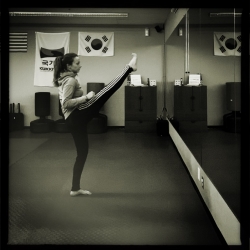
Introduction
If you’re a martial artist, you may have suffered a sore or injured knee at some point in your training. This article offers Kinesiology Taping (KT) as one way to assist with painful knees. You may be familiar with taping to immobilize a joint. That approach may be required in some situations. However, the approach offered here, KT, is designed to add stability while permitting movement.
Tape is not a magical cure, but KT can help with pain, bruises, range of motion, nerve entrapment, posture and swelling. Kinesiology Tape works as a physical cue, helping you focus and move properly. If you as a martial artist and suffer persistent knee problems, it’s very important to fix the root of the problem. Seeing a physical therapist or a movement therapist is recommended.
Before Taping
Think of all the ways that martial artists rely on their knees. Kicking, ground work — there is so much that can go wrong. We may compromise proper posture or knee alignment to generate more power or to make our kicks look more impressive. Having the correct motions is very important, as incorrectly practicing a roundhouse kick for weeks may cause permanent damage.
Imagine moving from a TKD back stance to a front stance. This common movement might actually cause more damage than you imagine. The knee is supposed to follow the ankle to avoid misalignment. When it doesn’t, you may be stressing the knee, eventually leading to injury,
Although this article covers taping, it’s best to correct poor movement before injury occurs. Visual cues are the first step… Consider watching yourself in the mirror. Start with fixing the basics. Record yourself and analyze the movements, especially while sparring.
Taping the Knee
Kinesiology Tape is intended to help movement, not restrict it. Correct application of the tape should permit a normal range of motion. You may keep the tape in place for 3 to 5 days, and it’s perfectly fine to shower with it. If you are not comfortable with the specifics of taping your own knee, feel free to approach a certified professional.
Sit on a chair, with your leg bent at a 90 degree angle. This taping method will cause the knee and the tape to look “wrinkly” when you stand up and straighten the leg. Don’t worry; that’s how it suppose to look. If we apply tape when the leg is straight, bending the knee would unhelpfully stretch the tape. We are taping to allow normal range of motion while providing a physical cue to the martial artist.
Be careful with stretching the tape before applying it. We should stretch the tape, but it is usually less than a 50% stretch. To stabilize a joint, we apply tape without stretching it.
Use one or two short pieces of tape as shown in the pictures. Round the corners with scissors.

Rip the small piece in the middle as shown below. Use less than a 50% stretch of the tape in the middle of that piece(s) as shown.

When applying the tape to the skin, do not stretch the ends of the tape.
Use the longer piece and start at the edge. Lay the piece without stretching it and tape as shown. Repeat on the opposite side of the knee.



When done, the person with the taped joint should be able to move his or her knee normally, but will now be enjoying a physical cue for proper movement, along with added joint stability.
(Editor’s note: this is a great article for those of us who can relate to Louie Martin’s piece, Martial Arts: Getting in Shape While Destroying Your Body)
Have you tried KT? Do you believe it works, or is it only a fad? Let me know in the comments below.
- Young Athletes and Martial Arts Injuries - November 11, 2020
- Martial Journal Spotlight: Anthony DelMar On Adults in Traditional Martial Arts - April 3, 2020
- Ankle Mobility Stretches for Martial Arts - February 24, 2020

Great article! Taping has helped me with joint stability issues, as well as providing a cue for healthier movement.